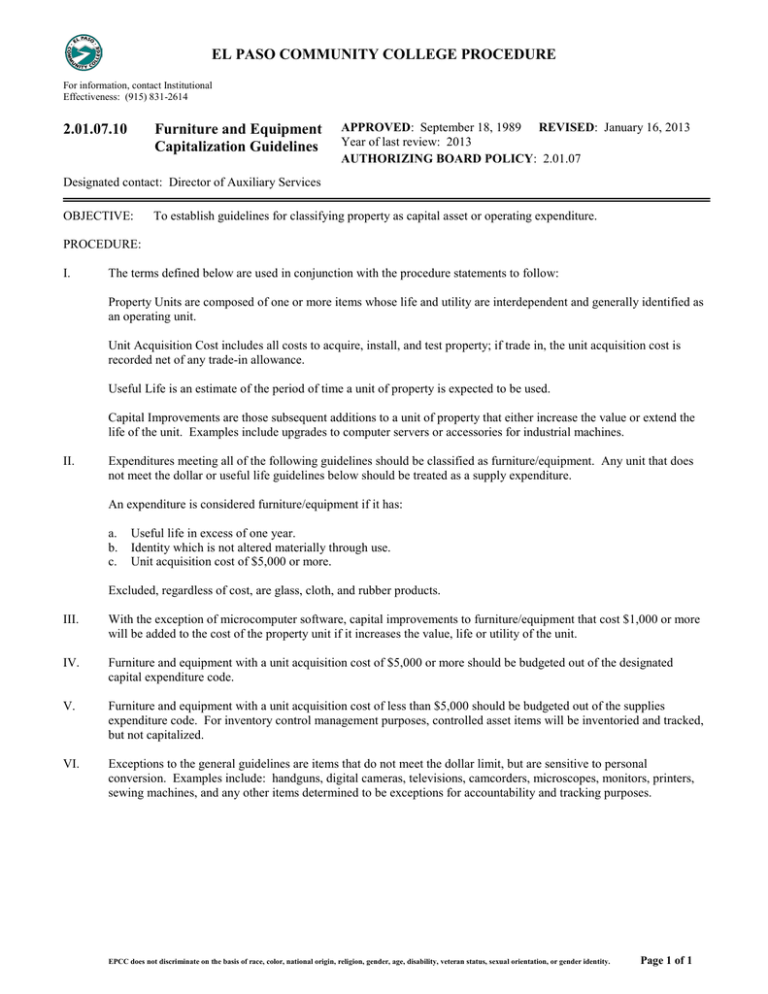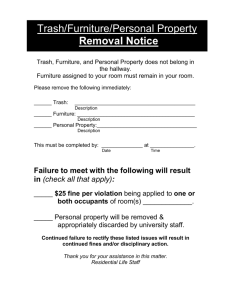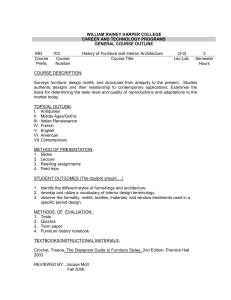EL PASO COMMUNITY COLLEGE PROCEDURE 2.01.07.10 Furniture and Equipment
advertisement

EL PASO COMMUNITY COLLEGE PROCEDURE For information, contact Institutional Effectiveness: (915) 831-2614 2.01.07.10 Furniture and Equipment Capitalization Guidelines APPROVED: September 18, 1989 REVISED: January 16, 2013 Year of last review: 2013 AUTHORIZING BOARD POLICY: 2.01.07 Designated contact: Director of Auxiliary Services OBJECTIVE: To establish guidelines for classifying property as capital asset or operating expenditure. PROCEDURE: I. The terms defined below are used in conjunction with the procedure statements to follow: Property Units are composed of one or more items whose life and utility are interdependent and generally identified as an operating unit. Unit Acquisition Cost includes all costs to acquire, install, and test property; if trade in, the unit acquisition cost is recorded net of any trade-in allowance. Useful Life is an estimate of the period of time a unit of property is expected to be used. Capital Improvements are those subsequent additions to a unit of property that either increase the value or extend the life of the unit. Examples include upgrades to computer servers or accessories for industrial machines. II. Expenditures meeting all of the following guidelines should be classified as furniture/equipment. Any unit that does not meet the dollar or useful life guidelines below should be treated as a supply expenditure. An expenditure is considered furniture/equipment if it has: a. b. c. Useful life in excess of one year. Identity which is not altered materially through use. Unit acquisition cost of $5,000 or more. Excluded, regardless of cost, are glass, cloth, and rubber products. III. With the exception of microcomputer software, capital improvements to furniture/equipment that cost $1,000 or more will be added to the cost of the property unit if it increases the value, life or utility of the unit. IV. Furniture and equipment with a unit acquisition cost of $5,000 or more should be budgeted out of the designated capital expenditure code. V. Furniture and equipment with a unit acquisition cost of less than $5,000 should be budgeted out of the supplies expenditure code. For inventory control management purposes, controlled asset items will be inventoried and tracked, but not capitalized. VI. Exceptions to the general guidelines are items that do not meet the dollar limit, but are sensitive to personal conversion. Examples include: handguns, digital cameras, televisions, camcorders, microscopes, monitors, printers, sewing machines, and any other items determined to be exceptions for accountability and tracking purposes. EPCC does not discriminate on the basis of race, color, national origin, religion, gender, age, disability, veteran status, sexual orientation, or gender identity. Page 1 of 1




